Update – New Version Available
2024-06-27 – A new version of this guide has been published: Raspberry Pi Network Boot Guide 2.0.
I’ve also updated a set of scripts that automate the Final Steps listed below, as well as help automate other administrative tasks. Read more in this companion article.
Introduction
In my spare cycles over the last couple of months, I’ve spent a significant amount of time refining my process for network booting Raspberry Pis on a Synology NAS. It took reading many other existing blogs, as well as the official Raspberry Pi network boot guide. In the end, I’ve figured out the nuances of booting a Pi 3B, Pi 3B+, and 4B on both NFS and iSCSI. While there are many guides out there on this subject, my goal is to bring all the secret sauce into one article that is comprehensive an geared toward Synology owners with home labs. This guide will also discuss some the challenges integrating RPi network boot with Google Wifi as the primary wireless Internet router, and some other lessons learned about my success or lack their of integrating network boot on an enterprise-grade switch vs. the typical unmanaged switches used in most home networks.
Prerequisites & Disclaimers
This is a reasonably advanced topic. If you are finding yourself getting lost with specific jargon, this may not be a good approach for you yet. While I have attempted to make this article very complete with safe command line and configuration syntax that can be copied into your own environment, you may damage the configuration of your home network, accidentally delete data, or cause ancillary problems (aka collateral damage). I offer no guarantees or support if following this guide does harm or doesn’t yield your desired results. So, follow my practices at your own risk.
Synology references pertain to DSM 6.x Raspberry Pi OS references pertain to Debian Buster; however, I have successfully tested this methodology on the latest Raspberry Pi OS (Debian Bullseye) as well as on the 64-bit version of the OS and it works well.
Also, you should be leveraging firewalls on each of your endpoints, and especially on your Synology NAS. The proper configuration of these various host and device firewalls is automatically assumed and is not explicitly covered in this documentation.
Why network boot a Raspberry Pi?
There are a lot of reasons why someone would want to boot a Raspberry Pi (RPi) with network storage. For one, I have a number of projects that involve leveraging RPis for compute in my home lab. This has numerous advantages over virtual machines or more expensive PC builds in my home lab. RPis use less electricity, produce less waste heat, are a magnitude smaller than even the some of the smallest form factor PCs. For all of the benefits of the RPis, its weakest link is the use of micro SD memory cards as a primary root volume. While SD cards are very affordable and quite compact, they have a limited number of write cycles, and depending on how much you spend there are varying degrees of design quality that make things like wear-leveling and environmental tolerance a bit inconsistent across brands and manufacturers.
By network booting, Pis can offload their IO to a centralized source that has much faster drives without having to consume additional space, power, and complexity to use USB drive enclosures. In addition, when leveraging a NAS, your RPis can take advantage of advanced features like RAID-protected volumes, snapshots, replication, and cloud backup. For me, this is critical. I don’t want to spend the time to build rich services in my home lab only to have the effort wiped out due to a failed SD card, human error, or environment factors. Network booting also allows you the ease of centralizing some of the configuration elements of your RPis in one place. This can save you time if you need to push configuration changes to multiple systems without interacting with them directly.
Why Synology?
If you are like me, you have already invested in a NAS or Network Attached Storage device for your home. My favorite brand is Synology. They are affordable offer a wide assortment of models, configurations, and features that are stable and consistent to deploy with easy. When I get home from work and have free time for technology-focused hobbies and research, the last thing I want to do is spend a lot of time wrestling with complexity.
Synology solved a lot of those problems for me for almost a decade, and depending on the model you purchase and how you configure the drives, it can become the centerpiece of your home lab / media center too. My preference has been for the ‘Plus’ series models, as they typically have the widest assortment of configurations that allow for external expansion units, as well allowing users to easily upgrade RAM and make simple internal repairs. My current primary model is a DS716+, so it is neither the newest or the oldest model on the block.
In the case of this guide, any model Synology model should support the basic features required in this guide. If you have a different NAS model from a different manufacturer or you’ve assembled your own, you can probably piece together your requirements by follow the same logic; however, it may not be as plug and play.
Which Raspberry Pis models are covered in this guide?
I will cover the nuances of booting the following three models:
- Raspberry Pi 3 Model B
- Raspberry Pi 3 Model B+
- Raspberry Pi 4 Model B
I will also explain how to use the Raspberry Pi Zero W to workaround specific technical challenges that may or may not exist in your environment; however, the RPi Zero W lacks an integrated Ethernet NIC, so it is not capable of network boot and will require the use of an SD card.
Which OSes will you cover in this guide?
I will exclusively cover using Raspberry Pi OS (Raspbian) that is based on Debian 10 (Buster), as it is the current officially supported OS from the Raspberry Pi Foundation.
In general, how do Raspberry Pis network boot?
While there nuances between each RPi model that impact the network boot process, they all more or less follow, or try to follow, the same overall process. I’ve created a diagram that I’ve attached below to illustrate the common process:

Preparing the RPi 3B for network boot
There are few things that have to happen with the older RPi 3B to prepare it for network boot, as well as getting it to consistently boot from the network. They are as follows:
- Write a Raspberry Pi OS (Lite) image to an SD Card and boot the RPi 3B.
- Log in as the default pi user and check if the RPi 3B is configured for set to the correct USB boot mode:
$ vcgencmd otp_dump | grep 17: 17:1020000a - The return value must be 17:3020000a
- If the return value is not 17:3020000a, set the USB boot mode in your OTP memory to the correct value, by adding the following to the bottom of your /boot/config.txt:
program_usb_boot_mode=1 - Reboot
- After rebooting, you should be able to verify that the USB boot mode is now properly set by running the vcgencmd from Step 2.
- Once verified, you can remove the line you added in Step 4 from your /boot/config.txt
Now your RPi 3B should be capable of booting off of the network. This can be tested by booting without the SD Card. You should notice that the NIC will now initialize without an SD card present.
While it may seem like you are done with prep at this point, there is one critical caveat that effects this particular model. While it is now possible to network boot without the SD card, there are several hardcoded bugs that make this experience inconsistent and problematic on this model. In order to boot consistently off of the network, you will need to format an SD card with FAT32 and copy the bootcode.bin file to it. Next, you will need to place that SD card back into your RPi 3B in order to consistently network boot without errors, hangs, or weird other quirks.
The good news is that this SD card will only be used to read the bootcode.bin file to step around the hardcoded bugs in this particular model that often cause network boot to fail and nothing else. Any SD card that can handle the environment where the the RPi 3B will be installed should be suitable for this task.
The bad news is that there is no way to trust this configuration without still leveraging an SD card. Also, the RPi 3B only supports a 100Mbit NIC, compared to the 3B+ and 4B which support 1Gbit NICs. That said, the 3B is still a great RPi for certain workloads and it will consistently perform well if you can deal with the slower NIC and SD card caveat.
Congrats, this model is now prepared to network boot!
Preparing the RPi 3B+ for network boot
In general, these are fairly easy to configure for network boot, as most of the earlier bugs concerning this platform have been resolved. They are as follows:
- Write a Raspberry Pi OS (Lite) image to an SD Card and boot the RPi
- Log in as the default pi user and check if the RPi 3B+ is configured for set to the correct USB boot mode:
$ vcgencmd otp_dump | grep 17: 17:1020000a - The return value must be
17:3020000a - If the return value is not 17:3020000a, set the USB boot mode in your OTP memory to the correct value, by adding the following to the bottom of your /boot/config.txt:
program_usb_boot_mode=1 - Reboot
- After rebooting, you should be able to verify that the USB boot mode is now properly set by running the vcgencmd from Step 2.
- Once verified, you can remove the line you added in Step 4 from your /boot/config.txt
Unlike the RPi 3B, the 3B+ will consistently boot without an SD card containing bootcode.bin. Congrats, this model is now prepared to network boot!
Preparing the RPi 4B for network boot
In general, these are the easiest to configure for network boot and provide the best visual feedback; however, depending on when it was fabricated you may have to have to update the eeprom code prior to successfully achieving network boot.
- Write a Raspberry Pi OS (Lite) image to an SD Card and boot the RPi 4B.
- Log in as the default pi user and use raspi-config to set your RPi 4B to boot from the network if an SD card isn’t present or bootable:
$ sudo raspi-config - Select Advanced Options

- Select Bootloader Version

- Select Latest and let raspi-config download and write the latest bootloader.
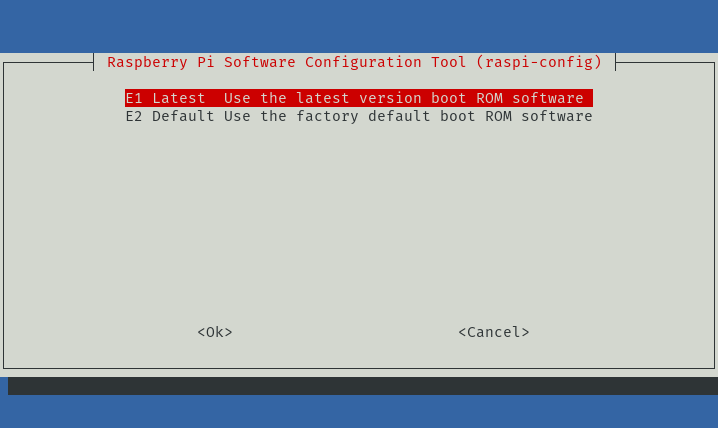
- Return to the Advanced Options from Step #3
- Select Boot Order
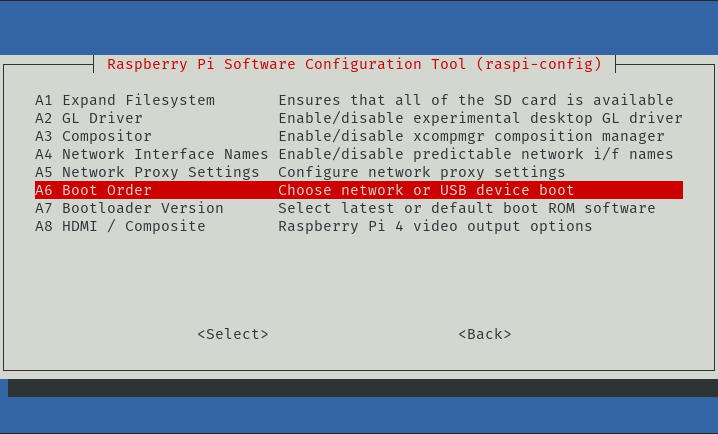
- Select Network Boot
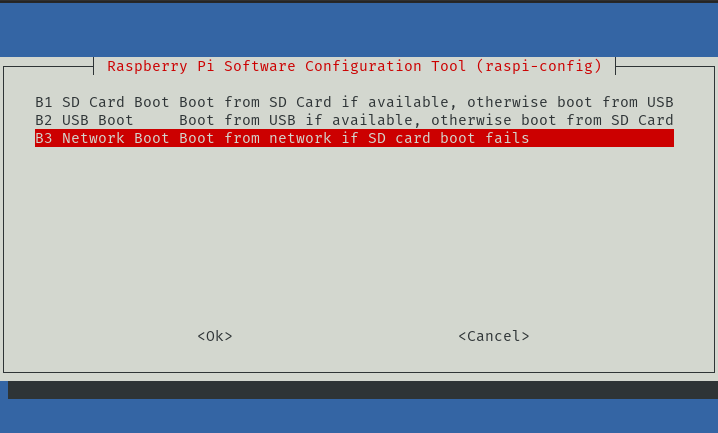
- This will program the RPi 4B to attempt to boot from the network when the SD Card is not present.
Unlike the RPi 3B, the 3B+ and 4B will consistently boot without an SD card containing bootcode.bin. Congrats, this model is now prepared to network boot!
My RPis are prepped, now what?
Well, that wasn’t too bad, was it? Now it’s time prepare your environment. In the next section, we’ll prepare the local area network, our Synology NAS, and the auxiliary services that actually will facilitate network boot.
Storage Overview
Regardless of your configuration, you will need the following services setup and configured on your NAS:
- NFS File Services
- You will need one share dedicated to host TFTP Boot Files. I call my share tftpboot. It is best if this share is exclusively reserved for use by NFS only.
- You will need to manage specific NFS permissions on this share for each RPi you wish to host, as well as the dnsmasq server if you decide to use one.
- iSCSI Services
- I recommend that you create a single iSCSI Target and LUN for each RPi you plan to boot. Additional LUNs can be added later, but that is beyond the scope of this article.
- For the root volume LUN, I recommend a 32GB LUN size, as it will be more than adequate for the OS, most basic application and server workloads, logging, and a small swap file.
- I make use of thin provisioning and advanced BTRFS features, but some of these features vary between NAS model numbers and your choice here will not impact overall functionality. Also, using thick provisioning and EXT4 will always yield better performance, but I accept the performance hit for all the BTRFS features.
Storage Recommendations
I have had great success running multiple Raspberry Pis off of a pair of mirrored SATA drives (Seagate IronWolf) using Synology Hybrid RAID, as well as many other Synology services. I generally create a storage pool for maximum flexibility vs. a straight volume. For those of you unfamiliar with Synology Storage Pools, it is a specific configuration that must be chose when you setup your NAS. Implementing it later will require additional steps, and it isn’t required for this anything covered in this guide.
If you have the physical expansion capacity, as well as budget, you may want to consider adding SSD drives, and possibly NVME drives on new models, to either host volumes or provide read/write caching.
While I have no trouble with just plain old SATA drives, my RPis are not necessarily IO-intensive. If you plan on running database or IOPS intensive workloads, you will want to have an SSD dedicated storage tier and possibly some more advanced caching features.
In my case, I have a dedicated computer with SSD that I use in my home lab to host databases on. This helps offload IO from the NAS and on to SSD. I then use the NAS as a backup target to store periodic database backups. Kubernetes is IO-intensive. I use the k3s implementation of Kubernetes from Rancher Labs/SuSE to power my RPi-based cluster. k3s allows the role of etcd to be offloaded to a external database. This works perfect for me, as it keeps all of the cluster-critical IO on SSD, while using the Synology for caching container images and logging. It’s also pretty helpful for other more common use cases, since the database services are typically where the bulk of IO occurs.
When I eventually upgrade my current Synology NAS, I intend to invest in a 4-bay model and have 2 mirrored SSD drives for application workloads and 2 for SATA.
Synology Storage Configuration
NFS Configuration
- Enable NFS Service and configure Advance Settings:
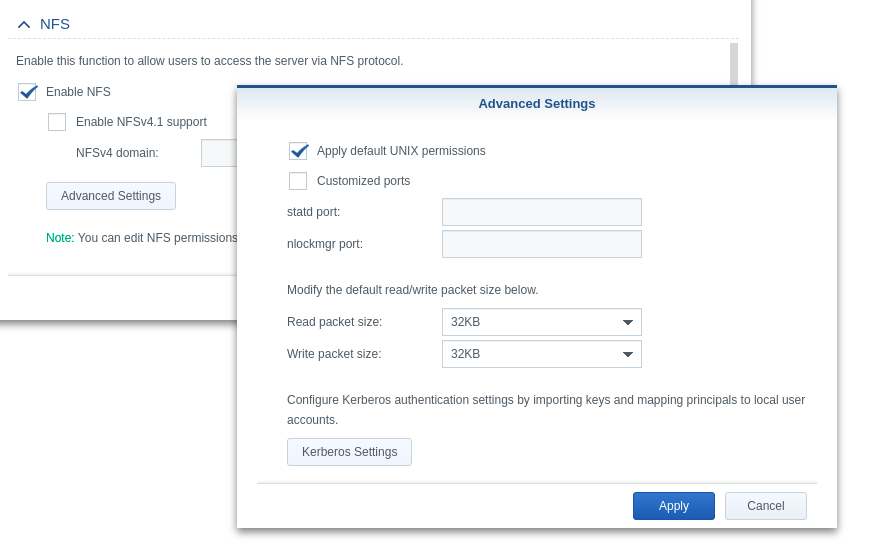
- Create a share called tftpboot.
- Edit the settings on the share:

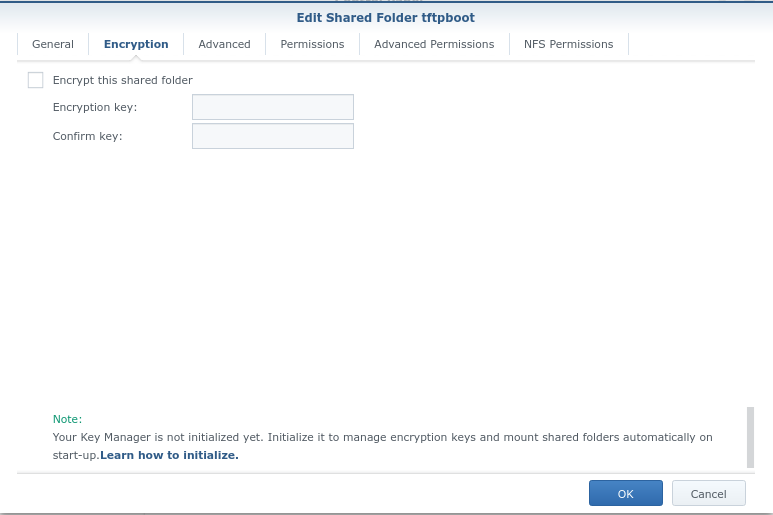

- Leave the Permissions/Advanced Permissions on their default settings.
- In the NFS Permissions, add the following entry for your dnsmasq server (if you have one):
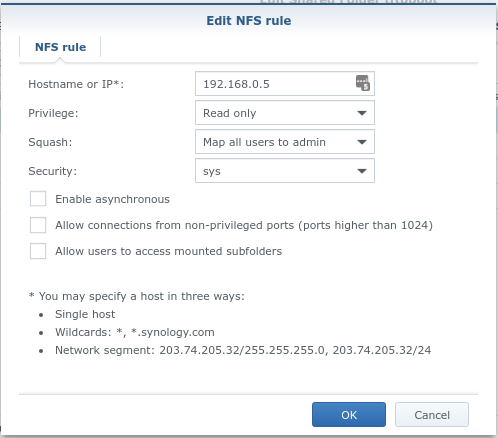
- Also in the NFS Permission, add an entry for each RPi that you wish to boot off the network:
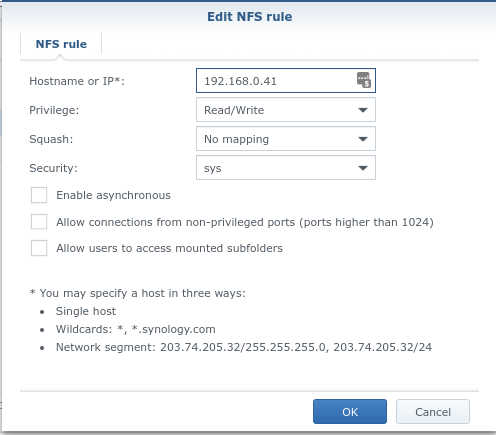
Next, you will correct UNIX file permissions and ownership on the directory structure. I’ve found the easiest way to do this is to ssh into the Synology directly by enabling SSH via the Terminal & SNMP menu in the control panel.
- Once you SSH into the Synology with an admin-level user account, elevate to root:
$ sudo -i - As root, change directories to the volume that is holds the tftpboot share (example: Volume 1):
# cd /volume1 - Ensure that the root user and group own the shared folder and reset the default permissions:
# chown root:root tftpboot # chmod -R 0755 tftpboot - Stop working on NFS for now. Now it is time to configure the necessary iSCSI components.
iSCSI Configuration
For performance and to reduce overhead, I do not recommend setting up CHAP authentication and CRC checksums. These features are overkill for most home environments and will degrade performance and add additional complexity.
Some blogs recommend enabling “multiple sessions”. This setting is not correct and this setting should remain disabled.
Here’s Synology’s official documentation:
Multiple Sessions: Allow multiple sessions from more than one initiator to connect to the same target at the same time. To protect your files from corruption or unexpected data loss, it is strongly suggested that you use a shared file system or cluster system such as VMware Virtual Machine File System (VMFS) and Oracle Cluster File System (OCFS).
Also, while this guide recommends thin provisioned LUNs with all advanced features enabled for flexibility, these advanced options are not required to support network booting and may not be available on your specific NAS model, or may be unavailable based on how you have configured your disk groups, volumes or file systems. Thick provisioning will result in higher performance and lower fragmentation, but it will immediately consume capacity equal to the maximum capacity of the LUN. Thin provisioning will only consume space as you use and consume it. The advanced features available with thin provisioning will allow you to potentially reclaim unused space back to the supporting volume, as well as leverage snapshots for additional recovery options.
- Configuring iSCSI targets
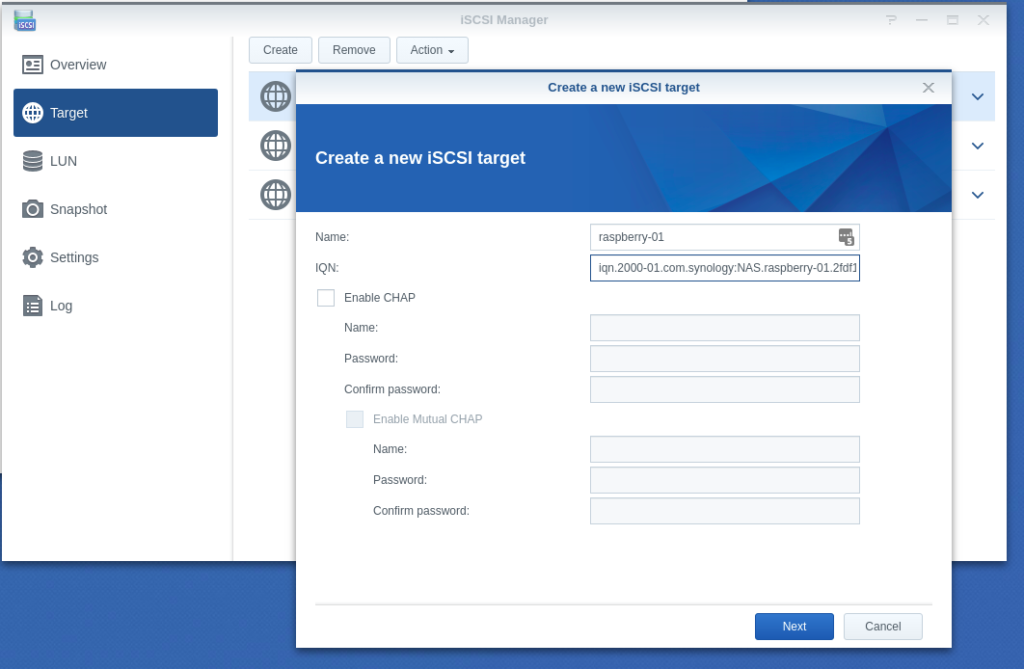
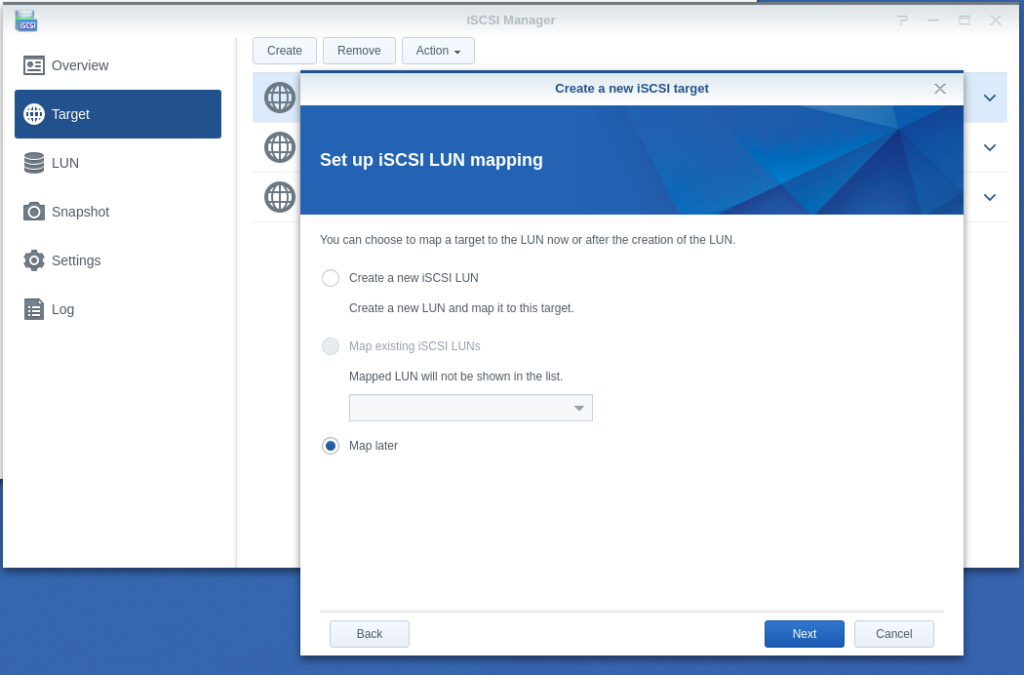
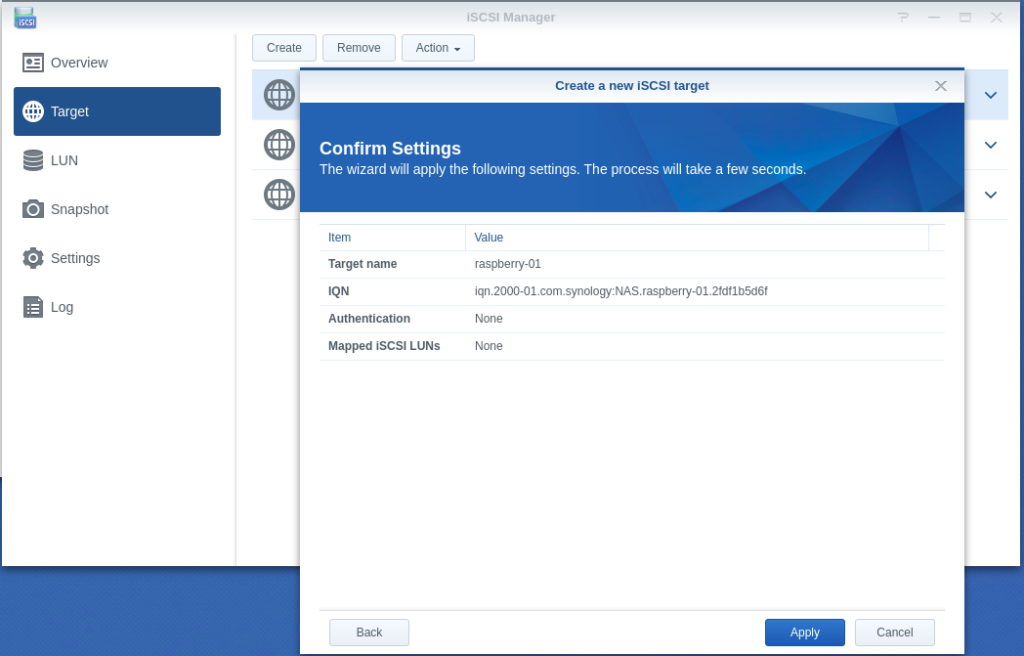
- Configuring LUN & Map LUN to Existing Target


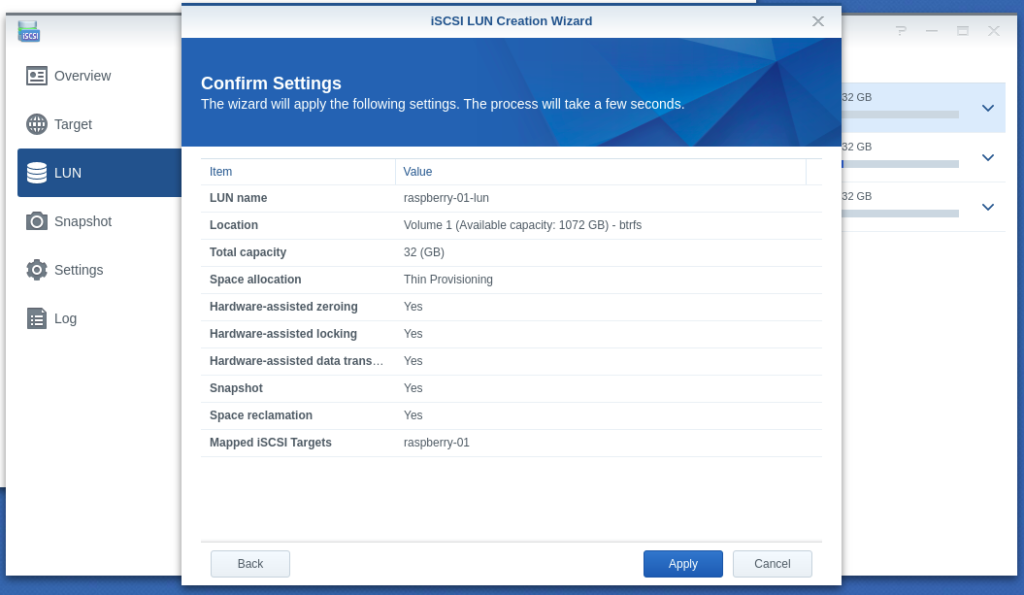
- Review iSCSI target settings and ensure that the default mask is set to no access:
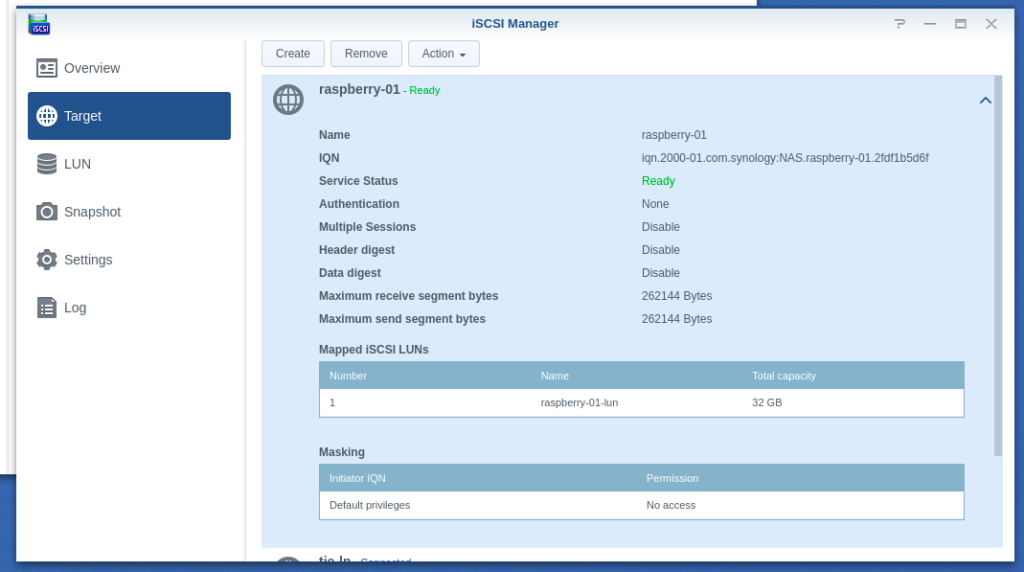
Repeat these steps for each RPi, assigning a unique iSCSI Target Name, IQN, and LUN to each RPi that you wish to setup.
We will revisit the iSCSI Manager in a later step to finalize the masking configuration in order allow the RPi to connect to the target with the unique initiator provided by the Raspberry Pi OS. While you can complete the masking step by specifying your own unique initiator name in advance, I tend to use the open-iscsi provided default initiator name, as it is unique and obscure enough for home use to prevent name collisions that can easily happen with less complicated names while iterating changes.
Network Preparation
It has been my experience, that Raspberry Pis, especially pre-4B models are a little kludgy in how they implement network boot and its Ethernet-based NIC. Therefore, I’m here to share a few basic tips to aid in your success:
- Don’t connect the Raspberry Pis to an enterprise-grade managed switch. In my case, I found that leveraging a modern HPE Procurve, even with most port-specific features and services disabled, resulted in the RPis not fully initializing and attempting DHCP requests. What ultimately solved all my issues was hosting my RPis on a cheap unmanaged switch which I then uplink to the HPE Procurve. In my case, the brand of unmanaged switch that I used was TP-Link, but any should work.
- Most home networks make use of DHCP to ease with network configuration. The DHCP on home networks is generally provided by the Internet router. Most of these routers lack the advanced configuration of the DHCP service which is required by the RPis for network boot. If that’s the case, you have 2 choices:
- Disable DHCP on your router, and move DHCP services to your Synology NAS.
- Leverage a VM or computer on your network capable of hosting a dnsmasq server which can proxy additional information required for network booting RPis in combination with your existing DHCP server.
- Leverage DHCP reservations for consistency of configuration. While it is possible to not use reservations, it makes the storage preparation and maintenance easier.
While it is possible to split scopes between multiple DHCP servers to increase redundancy, it is beyond the scope of this article and I will not be covering it. For my second tip, I’ve extensively tested when all DHCP/PXE/TFTP is controlled by the Synology with great success, as well as tested the use of a dnsmasq server to proxy additional DHCP information and handle PXE/TFTP functions. Again, it is beyond the scope of this article to explain more advanced hybrid approaches.
Option 1 – Move DHCP Services to your Synology NAS
This is fairly straight-forward until you get into the weeds of the configuration. Here are an outline of steps and some screenshots, where applicable, that will help you with the configuration steps on the Synology end of things:
- First, you will want to set a static IP address for the interface on your NAS that will be hosting the DHCP Server.
- Afterwards, you will need to enable the DHCP Server and define your scope(s) with all relevant basic network settings (dns, default gateway, etc).
- Create a share for your TFTP Boot Files (ex: tftpboot).
- Enable the TFTP Service and take the defaults advanced settings.
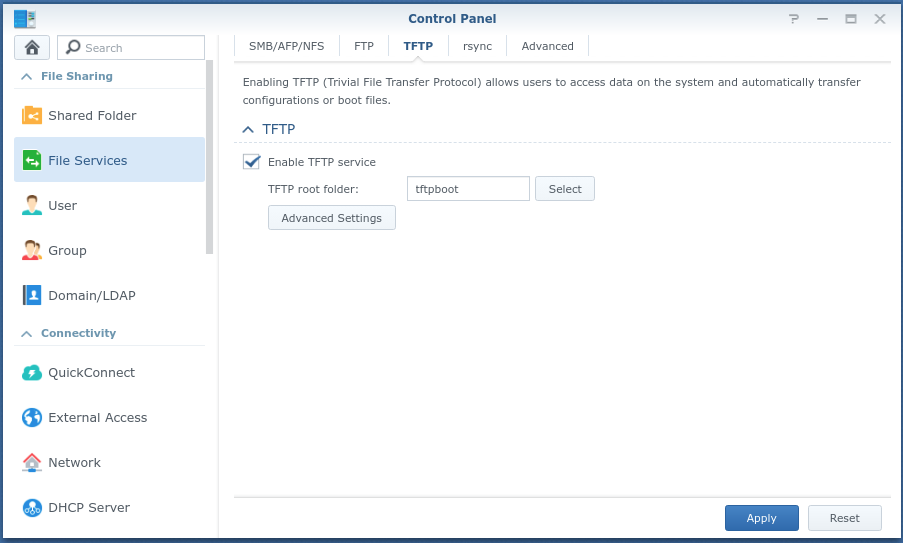
- Copy bootcode.bin to the root of your share for TFP Boot File (ex: tftpboot). It’s located on your SD Card image in /boot.
- Enable PXE Boot section within the DHCP Server Menu.
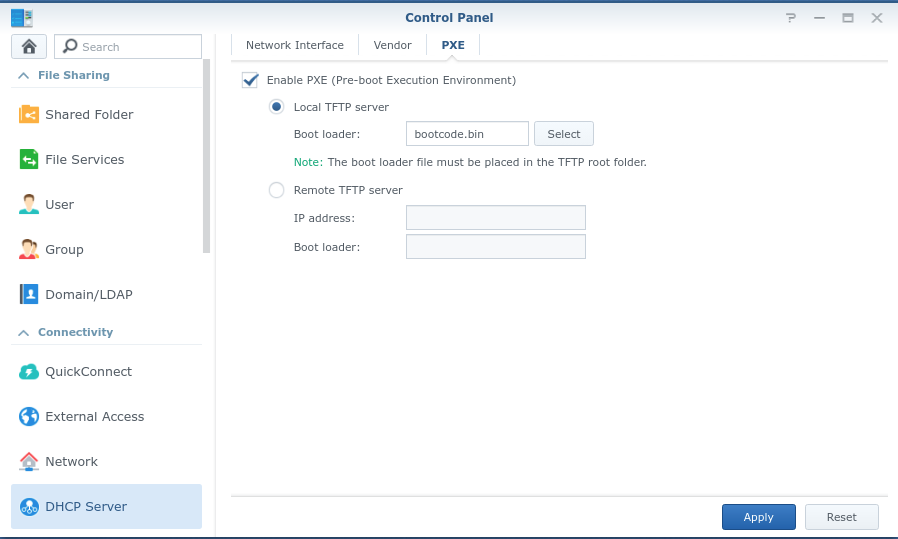
- Configure the additional configuration required by the RPis in the Vendor section within the DHCP Server Menu. (This is a critical step that cannot be skipped)
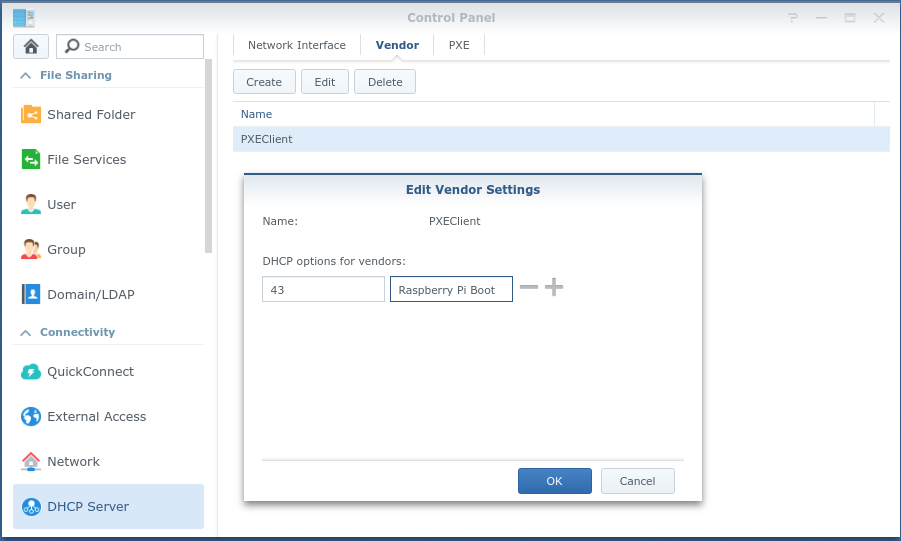
Option 2 – Configure a dnsmasq server
dnsmasq is an incredibly powerful service that we will leverage to do the following:
- Proxy additional information to clients that compliments the existing DHCP server configuration info on your network. This will eliminate the need to modify existing DHCP services.
- We also host TFTP/PXE services from this system that will front-end the Synology NAS-based TFTP Boot File over NFS.
On the VM or physical computer of your choice, install a Linux distribution of your choice. In my case, I leveraged an underutilized RPi Zero W that existed on my network as an NGINX-based load balancer. While the WIFI adapter of the RPi Zero W is a bit of a bottleneck, I personally care more about reliability than boot speed. Feel free to select a VM or physical computer that works best for you. A wired system will most likely yield the best performance and lowest boot times. Once selected, please follow these steps:
- Install Linux
- As root, create a mount point for the TFTP Boot Files on the Synology. (ex: /mnt/tftpboot)
- Add a persistent NFS mount to /etc/fstab to your Synology. Here’s an example where 192.168.0.25 is the IP address of the Synology:
192.168.0.25:/volume1/tftpboot /mnt/tftpboot nfs defaults,vers=3,rsize=32768,wsize=32768 0 0 - Using your distribution’s package manager, install dnsmasq.
- Locate your dnsmasq.conf and replace it (as root) with the following and modify the dhcp-range value to match the broadcast address of your home network:
port=0 # dhcp-range's IP address should be set to the broadcast address of your existing home network. dhcp-range=192.168.0.255,proxy log-dhcp enable-tftp tftp-root=/mnt/tftpboot pxe-service=0,"Raspberry Pi Boot" # Delays sending DHCPOFFER and proxydhcp replies for at least the specified number of seconds. dhcp-mac=set:raspberry_pi,B8:27:EB:*:*:* dhcp-reply-delay=tag:raspberry_pi,2 - Next, stop and restart dnsmasq:
$ sudo systemctl stop dnsmasq $ sudo systemctl start dnsmasq - Your dnsmasq server is ready to go.
Final Steps
Finally, we will boot our RPi again normally off of the SD Card with a clean Raspberry PI OS Buster Lite image and then transfer boot and operating system files to the Synology. I would recommend configuring each RPi individually, as well as attaching each RPI to a display to assist with troubleshooting until you confirm that everything is working. Here are our final configuration steps:
- If you have have only been dealing with one RPi, then feel free to reuse the SD card from earlier; however, if you have been recycling the same SD for preparing multiple RPis, then wipe and re-image the card again. **You will need to wipe and rewrite the Raspberry Pi OS Buster Lite image after completion of this procedure, or manually regenerate various encryption keys (ex: ssh) which are generated on first boot.
- On the SD Card, go into the boot folder and create a blank file called ssh or ssh.txt. This file triggers the RPi to automatically accept SSH-based connections on boot. This will save you from having to attach a keyboard, and can ease setup.
- Set a DHCP Reservation for the PI and take note of the IP address.
- Boot RPi off of a clean Raspberry PI OS Buster Lite image and verify connectivity, by connecting via SSH to the device. (Remember, the default user will be pi and the default password is raspberry)
- Use raspi-config to configure your hostname, locale, time zone, keyboard layout, and WIFI country. (Note: To configure local keyboard layout, you will have to have a keyboard attached. If your are leveraging SSH, you can skip the keyboard layout for now.)
- Reboot
- Next, lets update our apt package lists and dependencies from our repositories and then update all packages, kernel, etc to latest stable version:
$ sudo apt-get update$ sudo apt-get full-upgrade - Reboot
- Install open-iscsi:
$ sudo apt-get install open-iscsi - Determine the default generated initiator name:
$ sudo cat /etc/iscsi/initiatorname.iscsi ## DO NOT EDIT OR REMOVE THIS FILE! ## If you remove this file, the iSCSI daemon will not start. ## If you change the InitiatorName, existing access control lists ## may reject this initiator. The InitiatorName must be unique ## for each iSCSI initiator. Do NOT duplicate iSCSI InitiatorNames. InitiatorName=iqn.1993-08.org.debian:01:a17ea0b81be9(ex: Initiator name above is iqn.1993-08.org.debian:01:a17ea0b81be9) - Finalize your Synology’s iSCSI configuration by returning to iSCSI manager and inserting your initiator name as a Read/Write mask under the corresponding iSCSI target in the iSCSI Manager’s Masking Submenu:
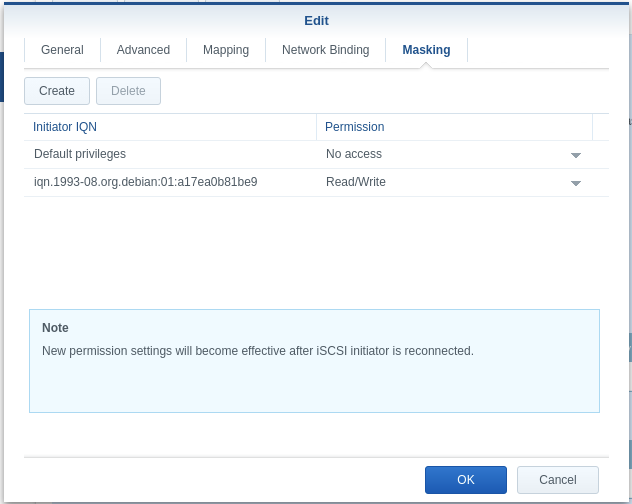
- Also, review the Network Binding Submenu. By default, all network interfaces will be selected, but in many cases most home users will probably be only using a single interface with their Synology. If that is the case, select the appropriate entry:
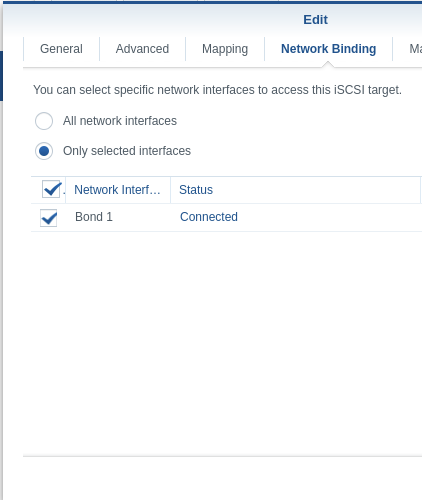
- Take note of your iSCSI Target IQN.
- Save your iSCSI Manager Settings and return to your RPi SSH session.
- Discover your iSCSI Targets:
- $ sudo iscsiadm -m discovery -t sendtargets -p <IP_OF_YOUR_SYNOLOGY_iSCSI_BINDING>
- The output of the previous command will vary depending on how many iSCSI Targets you have configured. Next, logon to your iSCSI Target:
- $ sudo iscsiadm -m node -l -T <TARGET_IQN> -p <IP_OF_YOUR_SYNOLOGY_iSCSI_BINDING>
- Check your /var/log/messages to see if you’ve successfully logged into your iSCSI Target. Your disk will most likely will be named /dev/sda.
- The iSCSI kernel drivers are not included with the default Raspberry Pi OS Kernel. As a result, you will need to create an initrd image that includes the missing components. First, inform initramfs to include the iSCSI module by creating the following file:
$ sudo touch /etc/iscsi/iscsi.initramfs
- Next, create the new initramfs image for your current kernel:
$ sudo update-initramfs -v -k `uname -r` -c
- Now take note of your initrd image filename by using the following command, as we will use soon:
$ ls -lrt /boot/init* -rwxr-xr-x 1 root root 9261831 Jun 20 14:57 /boot/initrd.img-5.10.17-v7+
- Next, take note of your RPi’s 8 character serial number (the preceding zeros can be omitted) with the following command, as we will use it soon:
$ grep Serial /proc/cpuinfo
- Next, we will temporarily mount the tftpboot share on the RPi by using the following command (assuming that your tftpboot share is on volume1):
$ sudo mount -t nfs -o defaults <IP_OF_YOUR_SYNOLOGY>:/volume1/tftpboot /mnt
- After mounting the root of the tftpboot share, our next step is to copy the universal RPi bootcode.bin to the root of the tftpboot share. bootcode.bin is used by all RPi models and must be in the root of this share for network-based boot to succeed:
$ sudo cp /boot/bootcode.bin /mnt
- Next recalling your notes, create a folder that matches the serial number (8 characters) without the preceding zeroes of the RPi:
$ sudo mkdir /mnt/<RPI_Serial>
- Clone your /boot partition to the folder that was created in the preceding step:
$ sudo rsync -avhP /boot/ /mnt/<RPI_Serial>
- Once the clone is complete, edit /mnt/RPI_Serial/config.txt and include the following line at the end of the file:
initramfs <INITRD_IMAGE_FILENAME> followkernel- Example:
initramfs initrd.img-5.10.17-v7+ followkernel
- Example:
- Next, we need to format and write a filesystem to our iSCSI LUN (the following command assumes /dev/sda as the root volume ):
$ sudo mkfs.ext4 /dev/sda
- Now retrieve and take note of your iSCSI LUN’s UUID. We will use this shortly to configure additional parameters:
$ sudo blkid /dev/sda
- Next, we must configure the kernel cmdline required to boot the root volume off of the iSCSI LUN. Edit /mnt/RPI_Serial/cmdline.txt and delete or comment out the first line, while adding the following, while modifying the specifics to settings from notes. These parameters must exist on a single line:
ip=::::<hostname>:eth0:dhcp root=UUID=<iSCSI_LUN_UUID> ISCSI_INITIATOR=<RPI_INITIATOR_IQN> ISCSI_TARGET_NAME=<iSCSI_TARGET_IQN> ISCSI_TARGET_IP=<IP_OF_YOUR_SYNOLOGY_iSCSI_BINDING> ISCSI_TARGET_PORT=3260 rwExample of a complete file (where the preexisting line was deleted):dwc_otg.lpm_enable=0 console=serial0,115200 console=tty1 ip=::::raspberrypi:eth0:dhcp root=UUID=747d83a1-01e9-480f-aed4-befb97a85e48 rootfstype=ext4 elevator=deadline fsck.repair=yes rootwait ISCSI_INITIATOR=iqn.1993-08.org.debian:01:a17ea0b81be9 ISCSI_TARGET_NAME=iqn.2000-01.com.synology:NAS.raspberry-01.2fdf1b5d6f ISCSI_TARGET_IP=192.168.0.5 ISCSI_TARGET_PORT=3260 rw
- Configuration of the tftpboot share is completed. Now we need to complete the configuration of our iSCSI LUN which will function as our root volume. Unmount the NFS share currently mounted on /mnt and mount the iSCSI LUN:
$sudo umount /mnt $ sudo mount -t ext4 -o defaults /dev/sda /mnt
- Clone the OS from SD Card to your iSCSI LUN excluding special directories and then recreate the special directories as blank directories:
- Clone:
$ sudo rsync -avhP --exclude /boot --exclude /proc --exclude /sys --exclude /dev --exclude /mnt / /mnt/
- Recreate Special Directories:
$ sudo mkdir /mnt/{dev,proc,sys,boot,mnt}
- Clone:
- Finally, you’ll need to modify the fstab file on your iSCSI LUN and remove or comment out all references to the SD Card (/dev/mmcblk0p*) and add an entry for your root and boot partitions. Here’s an example fstab:
proc /proc proc defaults 0 0 192.168.0.5:/volume1/tftpboot/b8b2337a /boot nfs nfsvers=3,_netdev 0 0 UUID=747d83a1-01e9-480f-aed4-befb97a85e48 / ext4 defaults,_netdev 1 1 #PARTUUID=8f17266b-01 /boot vfat defaults 0 2 #PARTUUID=8f17266b-02 / ext4 defaults,noatime 0 1 # a swapfile is not a swap partition, no line here # use dphys-swapfile swap[on|off] for that(192.168.0.5 should be the IP address of your Synology)
- You RPi should now support network boot. Try rebooting without an SD Card. If you are using a Raspberry Pi 3B, remember that you will need to use an SD Card formatted with a FAT32 partition and a copy of bootcode.bin to resolve hardcoded bugs.
Optional Configuration & Considerations
I recommend you add the following to the bottom of your /boot/config.txt file after network booting:
dtparam=act_led_trigger=heartbeatThe above parameter will make the RPi’s internal green LED, which defaults to disk activity, to instead follow a heartbeat pattern when the kernel loads. This is helpful when your system is headless to determine kernel crashes and if your RPi has successfully loaded the kernel on boot.
Also, for those wishing to network boot to create RPi-based Kubernetes Cluster, you may need to load a arm64 kernel to support various containers/components. While loading a 64bit kernel is trivial, remember you will need to generate new initrd image files for that kernel or your iSCSI root volume mount will fail at boot. For best results, enable the 64bit kernel mode on an SD Card-based boot, and generate a new initrd image file using the aforementioned procedure in this guide. Then copy the initrd image file to your tftpboot NFS share into the RPI_Serial_Number directory.
In addition, special care needs to be taken when upgrading the RPi’s kernel, as you may need to rebuild your initramfs image files in /boot and update your config.txt (also in /boot) to match your updated kernel version. To rebuild the initramfs image files, use the earlier command reference (located in Final Steps), but modify it to manually force the kernel version that you intend to boot. Remember, these options must be done prior to rebooting after updates or your system may hang on reboot.
Updates for DSM 7.0
I’ve found that there are certain settings that greatly reduce latency and present no issues to my running configuration:
NFS Configuration
- Enable NFSv4
- On each NFS share permissions screen, Enable asynchronous and Allow users to access mounted subfolders.
- Remove sync and nfsvers=3 from any /etc/fstab NFS-related mount options.
Enable Space Reclamation on RPis
Log in to each RPi that is netbooting off of iSCSI and enable fstrim.timer in systemd. Then either reboot or manually start the service.
Credits & Acknowledgments
This blog came from lots of quality snippets taken from other guides and technical articles, but I wanted to give praise and link back to both the Network boot your Raspberry Pi – Raspberry Pi Documentation, as well as Net boot (PXE + iSCSI) with a RaspberryPi 3 – darknao’s stuff
Both guides are some of the best I’ve seen covering this topic. Hopefully, this guide will synthesize knowledge from both to give a more complete picture and fill in more gaps to the process.
Conclusion
I hope this guide has been helpful to you. Please feel free to leave comments questions and feedback in the comments section below.
Discover more from Warmest Robot + Warmest Human
Subscribe to get the latest posts sent to your email.

Very Cool. I’ve been wanting to give something like this a go. Thanks for the walk-through.
Thanks for visiting Digasi!
Thanks for the DHCP delay 🙂
I didn’t find this information elsewhere.
Glad to help! I can’t take credit for that. I found that in the dnsmasq.conf that is included by default with RPI OS and wanted to call attention to it in my example. Thanks for visiting!
Still working through the details, but I found that the vendor config on the Synology didn’t do it for me. I couldn’t figure out how to get the UI to do it, but when I SSHed in and added
pxe-service=0,"Raspberry Pi Boot"to /etc/dhcp/dhcpd.conf and restarted dnsmasq (which it appears to be using for DNS) the PI started accepting the DHCP offers.Interesting. In my testing, that was not required if the Synology was the only DCHP server in use. I did have problems with Google Wifi, even if splitting the zones, with DHCP on the Synology, as this would cause the PIs to receive leases inconsistently.
I have a Google Wifi doing DHCP as well so that may be related. I’ve got the console wired up displaying the output in Minicom and I can see the DHCP responses coming back from both the Google Wifi and the Synology but the Pi doesn’t seem to accept anything until I added that line. For reference this is with a Pi4B.
It definitely is related. I try to keep my Synology as stock as possible, as I’ve found that their software updates will often blow out custom configuration changes. In my case, I use a "helper" PC or Pi to proxy the pi boot settings when using the Google Wifi. Otherwise, it is very inconsistent or doesn’t work, as you have observed. Your hack is good info though. I believe the stock dnsmasq config included with Raspberry Pi OS has the setting you mentioned. Hopefully, the guide was helpful. Thanks for visiting!
Yes, the guide has been extremely useful to me. Much appreciated.
On the Synology side, yes the configuration is extremely fragile. Even adding new static DHCP mappings blows it away… it’ll do for now though.
Currently experimenting with the 64-bit raspbian lite image, will see how closely it matches the guide. 🙂
Hi John, what a fantastic guide. Thank you very much for the detailed description. I got this running on my environment without problems (for one raspi only so far).
Do you know if it’s possible to have this config running with different OS Versions mixed? Like one raspi with RaspberryOS, another one with Ubuntu and a third one with an HomeAssistantOS image? I guess the bootcode.bin would not work for other Linux based OS than RaspberryOS or would it? Can you point me in the right direction to get something like this working?
Cheers, Stefan
Stefan,
I’m glad that guide is working well for you. I only run RPi OS (Raspbian) on my RPis and have successfully used and tested this guide with Debian 10 and 11. I believe the requirements to boot other OSes are roughly the same; however, some of the native utilities to control configuration elements of your RPis may not be present on alternative distributions (especially true for older RPis). I would recommend consulting the Raspberry Pi Foundation for more information on supported distributions and configuration tools. That being said, this guide does not share /boot partitions, so individual RPis could boot different versions of RPI OS or separate OSes without conflicting.
Also, I believe the bootcode.bin can be shared regardless of underlying distribution. The one thing to keep in mind is that the network boot process varies greatly between RPis and other devices (ex: PCs, other SBCs, etc) and probably can’t be intermixed without partitioning networks, storage, and alternate configurations. I hope that helps.
Excellent guide!! I got this working with a RPi 4 file server, pi-hole dhcp, and 2 netboot clients. Your RPi 3B instructions got my non-plus 3 to netboot as well! Except, on the RPi 3B, I get this:
pi@raspberrypi:~ $ sudo su –
sudo: /usr/bin/sudo must be owned by uid 0 and have the setuid bit set
pi@raspberrypi:~ $
HELP?!?
John,
I’m glad that you found the guide helpful. Chances are it’s related to file permissions pre or post-rsync. If you do an ‘ls -la /usr/bin’ what is the output?
I strongly recommend using zram as an alternate to any flash or HDD or networked swapfile. I have been using this for 2+ years on Raspberry PI 3B+ and PI 4 (4GB/8GB) machines and now run ONLY Ubuntu on the PI 4 machines. You have inspired me to figure out how to do this via Netboot. I have too many microSD drives that are "worn out." Note that zram is no longer default included in Ubuntu, you have to:
sudo apt install linux-modules-extra-raspi
Robert,
Thank you so much for the feedback. You’ve also inspired me! I’m experimenting with the impacts of zram in my configs and will look at adding an enhancement to the original post! I appreciate your readership and hope you continue to visit, participate, and share!
Thanks,
-John
Hi John,
really nice guide. I’ve been trying to set up my Pi 3B+ and Synology NAS DS218j, and this just seemed to be spot on.
I was getting on fine even if there area a few differences on the new DSM7.1, getting to boot the Pi with the tftpboot option, but then it fails after getting assigned an IP address from the NAS. It says:
No root device sepcified. Boot arguments must include a root= parameter.
It sits then with BusyBox. My guess was some error in the cmdline.txt and after checking it I found that I actually missed a part of a parameter, but still it’s not booting.
Any suggestion would be very appreaciated.
Kind regards from Canary Islands
Johann
Johann,
Thank you for your kind feedback! I am actively using the guide on DSM 7.1, and while the screenshots are dated, the configuration still works quite well. I am committed to try to provide fixes if any future updates cause a break/fix scenario with newer versions of DSM or RPi models. I’m sorry to hear that you’re having issues getting your Pis booting. I have a couple of questions for you? Have you tried my fish shell scripts on GitLab? They will help you bootstrap config files and sync the root volume, so you won’t have to do any of that by hand? I can also help you troubleshoot more if you can provide your cmdline.txt, config.txt, and a breakdown of your iscsi/nfs configuration. For me, the hardest part of the boot sequence was the tftp exchange because I was using an enterprise switch that was causing the RPis to not initialize their NICs properly for net boot. My cheap fix was moving them to an unmanaged switch. But, in general, if you see the kernel booting your NFS/tftp boot is correct. The next phase is getting the kernel to load the iscsi module so that the root volume can be found. If you load the kernel, but it stalls looking for the root volume, it means iSCSI misconfiguration, lack of kernel module added to initramfs, misconfigured cmdlines.txt, or the rsync of the root volume wasn’t quite right.
I hope this helps!
-John
Hey John,
thank you for your excellent guide!! I followed it step by step on my Syno 7.1 and even used your fish script, since my manual configuration always seemed to be wrong. That saved a LOT of time!!
The only thing that made a lot of trouble was my eeprom. I had to manually configurate it to find my tftserver.
Thank you a lot! keep up the good work 🙂
Lilian,
Thank you for your feedback! I am glad that you’ve found the guide useful. I need to update the screenshots for 7.x. Hope you come back and visit again! I will be adding more Homelab-related articles soon.
-John
Hi John,
Thank you for such a comprehensive guide.
I’m trying to move an existing Pi 4B’s files, to the NAS.
I think it would help, if you created separate information for the Pi 4B, as based on your earlier comment, that the 4B stores it’s bootcode.bin in it’s onboard EEPROM.
So, I’m left to wonder how many of the Final Steps are necessary for a Pi 4B, and exactly how to move my existing installation to the NAS.
Also, updating the screenshots for DSM7.2, would help, as there are quite a few differences to your screenshots.
Hi Jeremy,
Thanks for your feedback. There is a separate section for the PI 4B on how to prep the EEPROM. The bootcode.bin file should be in each of the RPI_serialnum-based subfolders of your tftpboot folder, as well as in the root of that folder. That’s the safest approach regardless of PI model that you are dealing with.
If you are struggling with a conversion, I have fish shell scripts that automate the process as long as the prerequisite steps are completed (ex: NAS configuration of iSCSI/NFS).
Given the popularity of the guide, I plan at some point at updating some of the screenshots; however, I tried to make the guide more comprehensive that my own self-serving needs require, so it would require some home lab configuration changes at this point to capture all the required screenshots to completely swap out all the pictures. The information and methods are still 100% accurate.
I think Synology added some confusing elements to their new UX interfaces for iSCSI/SAN storage that might be confusing to folks who are less familiar with the way that type of technology works. I’ll see what I can do to make it better!
Again, thanks for reading!
-John
Hi again John,
I have a Synology DS923+ running DSM 7.2-64570 Update 3, and it isn’t providing boot login information, even though I followed your guide exactly.
If the NAS is providing the DHCP server, the Pi never gets stuck at:
DHCP src: <NAS MAC IP>
YI_ADDR: <Pi IP>
SI_ADDR: <NAS IP>
but if I move the DHCP server to a Pi Zero, running Pi-hole, it starts booting, but gets stuck at:
Waiting for root device UUID=<iSCSI LUN’s UUID>…
There’s obviously a problem with the NAS, but I cannot work out what it is, because if I start the Pi with an SD card, there’s no issue accessing either the tftpboot directory, or it’s LUN.
Any suggestions?
Jeremy,
Congrats on the DS923+
I had been using older models, but picked one up for my family and homelab over the summer and it’s been a beast. Eventually, I’ll get some time to write up some articles about it and some of the latest experiments.
To answer some of your questions. I’ve never had issues with DHCP services from a Synology NAS. It’s dnsmasq under the hood…
My issues with DHCP in with RPis have stemmed from 2 of the following sources:
1.) Some RPis never fully initialize because of issues with the switch port they are on. I’ve gotten them stable on HPE Procurve Enterprise Switches, but dumb unmanaged switches are easier to deal with. So that could be part of this issue.
2.) If you have Google/Nest Wifi or some other very priority and invasive mesh systems, they will interrupt the RPi’s network boot sequences because they assume full control over all DHCP functions on your network. I was never able to get the DHCP services on my Synology to consistently work with Google/Nest Wifi. With a Google/Nest Wifi system functioning as a router, I would experience interrupted DHCP broadcasts causing my RPis to freeze randomly during boot.
When I replaced my Google/Nest Wifi system with an ASUS Home Mesh, or tested non-Google/Nest Wifi routers that were much older, DHCP from the Synology worked flawlessly. Remember, you must only have one DHCP server on your network or you must split DHCP scopes between multiple DHCP servers, so they can’t issue the same addresses. The Google/Nest systems couldn’t handle split scopes and DHCP couldn’t be disabled.
My recommendation is to use a boot helper VM, computer, or Pi, that uses dnsmasq to DHCP-proxy the necessary settings, as it always works regardless of your home router situation.
In your two scenarios, I have additional questions. Are you running stable updated bootcode on your RPi4s? Have you tried using my fish shell scripts that will write out your config files?
I understand trying to make the most of your hardware, but I’ve never tried running a Pi-hole on a boot helper with my config either. If it’s waiting for root device, you could have an issue with your iSCSI configuration, as I’m assuming you’ve tftboot’d your /boot partition over NFS, so this is where iSCSI receives the handoff to continue the boot process. Check your config.txt and cmdline.txt files for typos. On your Synology, review your initiator, target, and LUN mapping configs. You’re close!
-John
John,
I discovered a typo in the config.txt files.
After this, only one of my 11 Pi’s could network boot, so I assumed the switch that the other 10 are connected to was the problem. After a clean install of Bookworm, the 10 Pi’s could network boot. I don’t know why that changed.
But, I cannot get network booting to work, using the Synology as the TFTP server. It appears to me, it’s not providing the TFTP server address, as part of the DHCP information.
I believe having the Pi Zero, NAS and 10 Pi’s all connected to the same switch, rules out this switch as a problem.
And, I don’t have a Google/Nest Wifi or any mesh system.
So, network booting working, but not if the Synology is TFTP Server.
Hi John,
Network booting from the NAS is finally working, after a lot of work from Synology Support.
It works with the following configuration:
· TFTP service NOT enabled in DSM Control Panel
· No DHCP options for vendors in the DHCP Server Package settings
· PXE settings unchanged in DHCP Server Package settings
All relevant TFTP settings entered only in the dhcpd configuration files (see below), not in the DSM interface.
cat /etc/dhcpd/dhcpd-pxe.info
enable="yes"
cat /etc/dhcpd/dhcpd-pxe-setting
enable="yes"
is_remote_tftp="no"
local_bootloader="bootcode.bin"
cat /etc/dhcpd/dhcpd-pxe.conf
enable-tftp
tftp-root=/volume1/tftpboot
pxe-service=0,"Raspberry Pi Boot"
Hopefully, this can help anyone else be experiencing the same issues.
John,
There’s a couple of changes for the client setup, under Raspberry Pi OS version 12, which is called Bookworm.
The contents of /boot/firmware need to be copied to /mnt/<Serial Number>/, and iSCSI kernel drivers are now included in the default Raspberry Pi OS Kernel.
Jeremy,
Thanks for this feedback! I’ll try to incorporate this in an upcoming blog article. Folks keep reaching out asking for me to release a follow-up to the original guide with updated screenshots, new OS support, and discussion of the RPi5.
I’m trying to make more time in 2024 for blogging, so hang tight!
Whoops, the iSCSI drivers are NOT included in the default Raspberry Pi OS Kernel.
As part of the installation of open-iscsi, new versions of kernel8.img and kernel_2712.img are created, which include the iSCSI drivers.
Also, since the Raspberry Pi 4B was released, one can choose the network booting directory name, for Pi’s that have a boot EEPROM.
See: https://www.raspberrypi.com/documentation/computers/raspberry-pi.html#configuration-properties.
The specific command is:
TFTP_PREFIX=(0, 1 or 2)
where the directory name is:
0 = the serial number
1 = a string specified by TFTP_PREFIX_STR
2 = the MAC address.
TFTP_PREFIX_STR=directory_name/
where directory_name has a maximum length of 32 characters.
This makes it so much easier to identify the each boot directory, when you have multiple Pi’s network booting.
[…] first edition of the Raspberry Pi Network Boot Guide, originally dated 2021-06-21, was easily one of my most popular and visited blog articles. Based on comments and feedback from […]